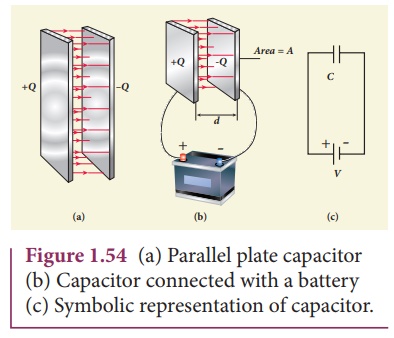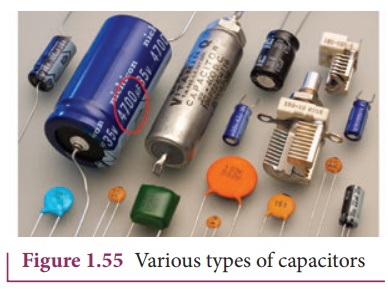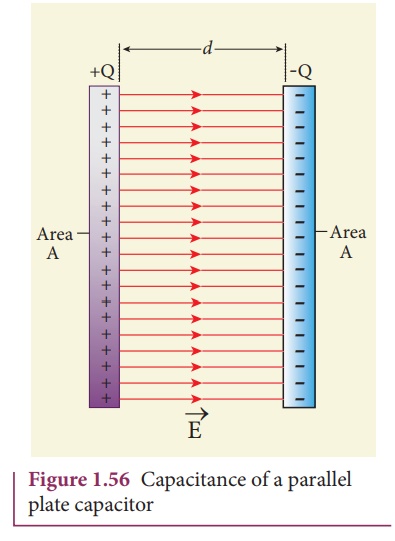Chapter: 12th Physics : Electrostatics
Capacitors
Capacitors
Capacitor is a device
used to store electric charge and electrical energy. It consists of two
conducting objects (usually plates or sheets) separated by some distance.
Capacitors are widely used in many electronic circuits and have applications in
many areas of science and technology.
A simple capacitor
consists of two parallel metal plates separated by a small distance as shown in
Figure 1.54 (a).

When a capacitor is
connected to a battery of potential difference V, the electrons are transferred
from one plate to the other plate by battery so that one plate becomes
negatively charged with a charge of –Q and the other plate positively charged
with +Q. The potential difference between the plates is equivalent to the
battery’s terminal voltage. This is shown in Figure 1.54(b). If the battery
voltage is increased, the amount of charges stored in the plates also increase.
In general, the charge stored in the capacitor is proportional to the potential
difference between the plates.
Q ∝
V
so that Q = CV
where the C is the
proportionality constant called capacitance. The capacitance C of a capacitor
is defined as the ratio of the magnitude of charge on either of the conductor
plates to the potential difference existing between the conductors.

The SI unit of
capacitance is coulomb per volt or farad (F) in honor of Michael
Faraday. Farad is a very large unit of capacitance. In practice, capacitors are
available in the range of microfarad (1µF = 10-6 F) to picofarad
(1pf = 10-12 F). A capacitor is represented by the symbol 
Note that the total
charge stored in the capacitor is zero (Q - Q = 0). When we say the capacitor
stores charges, it means the amount of charge that can be stored in any one of
the plates.
Nowadays there are
capacitors available in various shapes (cylindrical, disk) and types (tantalum,
ceramic and electrolytic), as shown in Figure 1.55. These capacitors are
extensively used in various kinds of electronic circuits.

Capacitance of a parallel plate capacitor
![]()
![]() Consider a
capacitor with two parallel plates each of cross-sectional area A and separated
by a distance d as shown in Figure 1.56.
Consider a
capacitor with two parallel plates each of cross-sectional area A and separated
by a distance d as shown in Figure 1.56.

The electric field between two infinite parallel plates is uniform and is given by E = σ / ε0 where
σ is the surface charge density on the plates (σ=Q/A) If the separation distance d is very
much smaller than the size of the plate (d2 << A), then the
above result is used even for finite–sized parallel plate capacitor.
The electric field between
the plates is

Since the electric field
is uniform, the electric potential between the plates having separation d is
given by

Therefore the
capacitance of the capacitor is given by

From equation (1.84), it
is evident that capacitance is directly proportional to the area of cross
section and is inversely proportional to the distance between the plates. This
can be understood from the following.
(i) If the area of
cross-section of the capacitor plates is increased, more charges can be
distributed for the same potential difference. As a result, the capacitance is
increased.
(ii) If the distance d
between the two plates is reduced, the potential difference between the plates
(V = Ed) decreases with E constant. As a result, voltage difference between the
terminals of the battery increases which in turn leads to an additional flow of
charge to the plates from the battery, till the voltage on the capacitor equals
to the battery’s terminal voltage. Suppose the distance is increased, the
capacitor voltage increases and becomes greater than the battery voltage. Then,
the charges flow from capacitor plates to battery till both voltages becomes
equal.
Example 1.20
A parallel plate
capacitor has square plates of side 5 cm and separated by a distance of 1 mm.
(a) Calculate the capacitance of this capacitor. (b) If a 10 V battery is
connected to the capacitor, what is the charge stored in any one of the plates?
(The value of εo = 8.85 x 10-12 Nm2 C-2)
Solution
(a) The capacitance of
the capacitor is

= 221.2 ×10−13
F
C = 22 . 12 ×10−12
F = 22 .12 pF
(b) The charge stored in
any one of the plates is Q = CV, Then
= 22 . 12 ×10−12
×10 = 221.2 ×10−12 C = 221.2 pC
Related Topics